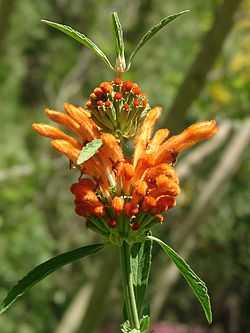Leonotis leonurus
| Leonotis leonurus | |
|---|---|
 | |
| Leonotis leonurus | |
| Scientific classification | |
| Kingdom: | Plantae |
| (unranked): | Angiosperms |
| (unranked): | Eudicots |
| (unranked): | Asterids |
| Order: | Lamiales |
| Family: | Lamiaceae |
| Genus: | Leonotis |
| Species: | L. leonurus |
| Binomial name | |
| Leonotis leonurus (L.) R.Br.[1] | |
Leonotis leonurus, also known as lion's tail and wild dagga, is a plant species in the Lamiaceae (mint) family. The plant is a broadleaf evergreen large shrub native to South Africa and southern Africa, where it is very common.[2] It is known for its medicinal and mild psychoactive properties. The main psychoactive component of Leonotis leonurus is leonurine.

Description
The shrub grows 3 to 6 ft (1 to 2 m) tall by 1.5 to 3.5 feet (0.46 to 1.07 m) wide.[2] The medium-dark green 2–4 inches (5.1–10.2 cm) long leaves are aromatic when crushed. The plant has tubular orange flowers in tiered whorls, typical to the mint family, that encircle the square stems. They rise above the foliage mass during the summer season, with flowering continuing into winter in warmer climates.[2][3]
- Variation in flower color
A white variety (known colloquially as 'Alba'), as well as a yellow variety also exist.
- Ecology
In its native habitats Leonotis leonurus attracts nectivorous birds (mainly sunbirds), as well as various insects such as butterflies. The flowers' mainly orange to orange-red colour and tubular shape are indicative of its co-evolution with African sunbirds, which have curved bills suited to feeding from tubular flowers.
Cultivation
Leonotis leonurus is cultivated as an ornamental plant for its copious orange blossom spikes and accent or screening qualities for use in gardens and parks.[2][3] It is a moderate drought tolerant plant, and a nectar source for birds and butterflies in landscape settings.[2]
Lion's tail can especially be found in other subtropical and Mediterranean climate regions beyond South Africa such as California, Hawaii,[3] and Australia where it has naturalized in areas. In cooler climates it is used as an annual and winter conservatory plant.[2]
Toxicology and pharmacology
An animal study in rats indicated that in high doses, lion's tail has significant toxicological adverse effects on organs, red blood cells, white blood cells and other important bodily functions.[4]
One experimental animal study suggests that the aqueous leaf extract of Leonotis leonurus possesses antinociceptive, antiinflammatory, and hypoglycemic properties.[5]
Recreational uses
The dried leaves and flowers have a mild calming effect when smoked. In some users, the effects have been noted to be similar to the cannabinoid THC found in Cannabis, except that it has a much less potent high.[6] It has also been reported to cause mild euphoria, visual changes, dizziness, nausea, sweating, sedation and lightheadedness.
It is sometimes used as a Cannabis substitute by recreational users as an alternative to illegal psychoactive plants. Leonotis leonorus is not currently scheduled under federal law in the United States.
The picked and dried leaves are also commonly brewed as a tea.
See also
References
- ↑ "Leonotis leonurus information from NPGS/GRIN". www.ars-grin.gov. Retrieved 2008-12-04.
- ↑ 2.0 2.1 2.2 2.3 2.4 2.5 MBC-Kemper Center - Leonotis leonurus . accessed 7.7.2011
- ↑ 3.0 3.1 3.2 "PLANTS Profile for Leonotis leonurus (lion's ear)". United States Department of Agriculture Natural Resources Conservation Service. Retrieved 28 March 2010.
- ↑ Maphosa, V; Masika, P; Adedapo, A (2008). "Safety evaluation of the aqueous extract of Leonotis leonurus shoots in rats". Human & Experimental Toxicology 27 (11): 837–43. doi:10.1177/0960327108099533. PMID 19244291.
- ↑ Ojewole JA (May 2005). "Antinociceptive, antiinflammatory and antidiabetic effects of Leonotis leonurus (L.) R. BR. [Lamiaceae] leaf aqueous extract in mice and rats". Methods and Findings in Experimental and Clinical Pharmacology 27 (4): 257–64. doi:10.1358/mf.2005.27.4.893583. PMID 16082426.
- ↑ "Erowid Leonotis leonurus (Lion's Tail) Vault". Erowid. 9 September 2009. Retrieved 28 March 2010.
External links
| Wikimedia Commons has media related to Leonotis leonurus. |
| Wikispecies has information related to: Leonotis leonurus |